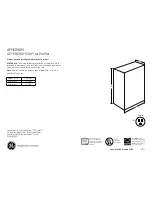
31
RS4100004 Rev. 0
Cooling Performance Test
A common reason for inefficient cooling is reduced air
movement caused by a dirty condenser, evaporator, and/
or air filter. Inspect each of these components and clean,
if necessary, before performing the following test.
Best results are obtained when cooling test is conducted
under "peak load" conditions.
1. Attach thermometers to unit under test at specified
locations (see paragraph
Using Cooling Performance
Test Thermometers).
2. Apply power to unit under test. Place
FAN CONTROL
in high cooling position,
TEMPERATURE CONTROL
to coolest setting, and
VENT CONTROL to closed
position. Allow unit to run at least 20 minutes before
any readings are taken.
3. Record following temperatures:
A. Temperature at return air vent (Location 1 in
Thermometer Testing Location diagram).
B. Temperature at discharge vent (Location 2 in
Thermometer Testing Location diagram).
C. Wet bulb and dry bulb sling psychrometer read-
ings (see paragraph
Taking Sling Psychrometer
Readings).
NOTE: Dry bulb sling psychrometer reading should be
±1°F of temperature recorded at return air vent.
4. Calculate difference between temperature readings
taken in step 3A and 3B (subtract temperature
recorded in step 3B from temperature recorded in
step 3A). Record results.
NOTE: The remaining steps explain how to determine if
unit under test is operating within specifications,
using temperatures recorded in previous steps.
See
Cooling Dry Bulb Range Chart (on Technical
Sheet for unit under test) to complete remaining
steps. See
Using Cooling Dry Bulb Range Chart
graphic for additional directions.
5. Under
DRY BULB, in ROOM TEMPERATURE
column, find temperature nearest to the temperature
recorded in step 3A (for example, if temperature
recorded in step 3A was 87°F, the nearest
temperature on chart would be 85°F). Use associated
wet bulb temperatures (shown in next column on
chart) in following step.
6. Using wet bulb temperatures associated with dry bulb
temperature located in previous step, find
temperature on chart nearest to wet bulb sling
psychrometer reading obtained in step 3C.
7. Note minimum (MIN) and maximum (MAX) values
shown to right of associated dry bulb/wet bulb
temperatures.
Unit under test is within cooling specifications if
temperature difference calculated in step 4 falls within
minimum and maximum values noted in step 7. Unit is
out of specifications if calculation from step 4 is greater
or less than values from step 7. (See paragraph
Performance Test Diagnosis Guide for additional
information.)
Cooling Dry Bulb Range Chart
Room Temperature
Dry Bulb
Temperature
Change
°F Dry Bulb
°F Wet Bulb
MIN
MAX
85
5
9
90
80
8
13
75
12
17
70
16
20
80
6
10
85
75
9
14
Find temperature
nearest to that
recorded in step 3A
in this column.
Calculated temperature
difference should be within
minimum and maximum
values shown in last two columns.
Find associated
wet bulb
temperature here
Using Cooling Dry Bulb Range Chart
Performance Tests
!
WARNING
To avoid risk of electrical shock, personal injury, or death, disconnect electrical power source to unit and
discharge capacitor through a 10,000 ohm resistor before attempting to service, unless test procedures require
power to be connected. Ensure all ground wires are connected before certifying unit as repaired and/or
operational.











































